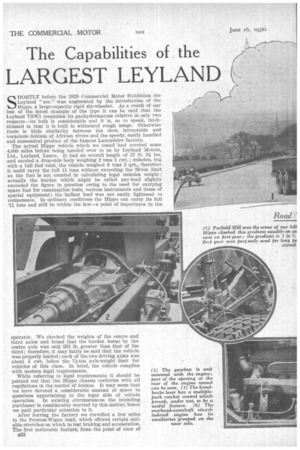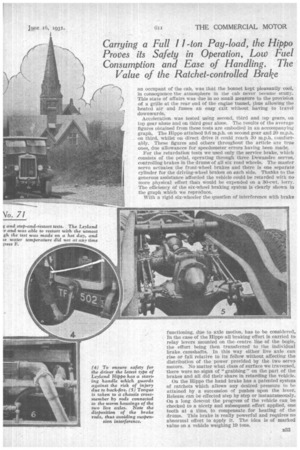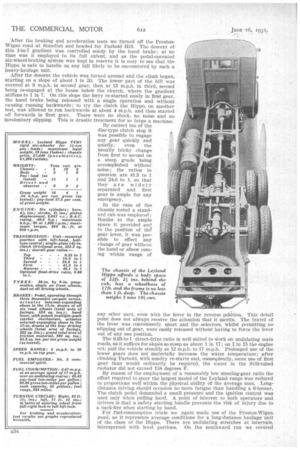The Capabilities of the
Page 50

Page 51

Page 52

Page 53

If you've noticed an error in this article please click here to report it so we can fix it.
LARGEST LEYLAND
SHORTLY before the 1929 Commercial Motor Exhibition the Leyland " zoo " was augmented by the introduction of the Hippo, a large-capacity rigid six-wheeler. As a result of our test of the latest example of the type it can be said that the Leyland TSW1 resembles its pachydermatous relative in only two respects—its bulk is considerable and it is, so to speak, thickskinned in that it is built to withstand rough usage. Otherwise there is little similarity between the slow, intractable and voracious denizen of African rivers and the speedy, easily handled and economical product of the famous Lancashire factory.
The actual Hippo vehicle which we tested had covered some 4,000 miles before being handed over to us by Leyland Motors, Ltd., Leyland, Lancs. It had an overall length of 27 ft. 31 ins. and carried a drop-side body weighing 2 tons 1 cwt.; 'unladen, lou„t. with a lull fuel tank, the vehicle weighed 8 tons 2 qrs., therefore it could carry the full 11 tons without exceeding the 19-ton limit as the fuel is not counted in calculating legal unladen weight ; actually the burden which might be called pay-load slightly exceeded the figure in question owing to the need for carrying spare fuel for consumption tests, various instruments and items of special equipment ; the ballast load was not easily lightened to compensate. In ordinary conditions the Hippo can carry its full 11 tons and still be within the law—a point of importance to the operator. We checked the weights of the centre and third axles and found that the burden borne by the centre axle was only 231 lb. greater than that of the third ; therefore, it may fairly be said that the vehicle was properly loaded ; each of the two driving axles was about 5 cwt. below the 74-ton axle-weight limit for vehicles of this class. In brief, the vehicle complies with modern legal requirements.
While referring to legal requirements it should be pointed out that the Hippo chassis conforms with all regulations in the matter of brakes. It may seem that we have devoted a considerable amount of space to questions appertaining to the legal side of vehicle operation. In existing circumstances the intending purchaser is considerably worried by this matter, hence we paid particular attention to it.
After leaving the factory we travelled a few miles to the Preston-Wigan road, which offered certain suitable stretches on which to test braking and acceleration. The first noticeable feature, from the point of view of B32 an occupant of the cab, was that the bonnet kept pleasantly cool, in consequence the atmosphere in the cab never became sturry. This state of affairs was due in no Mall measure to the provision of a grille at the rear end of the engine tunnel, thus allowing the heated air and fumes an easy exit without having to travel downwards.
Accelerationwas tested Ming second, third and rep gears, on top gear alone and on third gear alone. The results of the average figures obtained from these tests are embodied in an accompanying graph. The Hippo attained 9.6 m.p.h. on second gear and 20 m.p.h. on third, whilst on direct drive it could reach 30 m.p.h. comfortably. These figures and others throughout the article are true ones, due allowances for speedometer errors having been made. For the retardation tests we used only the service brake, which consists of the pedal, operating through three Dewanclre servos, controlling brakes in the drums of all six road wheels. The master servo actuates the front-wheel brakes and there is one separate cylinder for the driving-wheel brakes on each side. Thahks to the generous assistance afforded the vehicle could be retarded with -no more physical effort than would be expended on a 30-cwt. lorry. The efficiency of the six-wheel braking system is clearly shown in the graph which we reproduce.
With a rigid six-wheeler the question of Interference with brake functioning, due to axle motion, has to be considered. In the case of the Hippo all braking effort is carried to relay levers mounted on the centre line of the bogie, the effort being then transferred to the individual brake camshafts. In this way either live axle can rise or fall relative to its fellow without affecting the distribution of the power provided by the two servo motors. No matter what class of surface we traversed, there were no signs of " grabbing " on the part of the brakes and all did their share in retarding the vehicle.
On the Hippo the hand brake has a patented system of ratchets which allows any desired pressure to be attained by a succession of pushes upon the lever. Release can be effected step by step or instantaneously. On a long descent the progress of the vehicle can be checked to a nicety and subsequent effort applied, one tooth at a time, to compensate for heating of the drums. This brake is really powerful and requires no abnormal effort to apply it. The idea is of marked value on a vehicle weighing 19 tons. 'After the braking and acceleration tests we turned off the PrestonWigan road at Standish and headed for Parbold Hill. The descent of this 1-in-7 gradient was controlled solely by the hand brake; at no time was it employed to its full extent, and as the pedal-operated six-wheel-braking system was kept in reserve it is easy to see that the Hippo Is safe to handle on any hill likely to be encountered by such a heavy-haulage unit.
After the descent the vehicle was turned around and the climb began, starting on a slope of about 1 in 20. The lower part of the hill was covered at 9 m.p.h. in second gear, then at 13 m.p.h. in third, second being re-engaged at the house below the church, ,where the gradient stiffens to 1 in 7. On this slope the lorry re-started easily in first gear, the hand brake being released with a single operation and without causing running backwards; to try the clutch the Hippo, on another test, was allowed to run backwards at about 4 m.p.h. and then started off forwards in first gear. There were no shock, no noise and no involuntary slipping. This is drastic treatment for so large a machine.
By correct use of the disc-type clutch stop it was possible to engage any . gear quickly and quietly, even the usually tricky change from first to second on a steep grade being accomplished without noise; the ratios in question are 41.3 to 1 and 24.6 to 1, so that they are widely separated and first gear is ample for any emergency.
In the case of the chassis tested a standard cab was employed: thanks to the ample space it provided an to the position of th6 gear lever, it was possible to effect any change of gear without the hand or elbow corning within range of any other part, even with the lever in the reverse po'sitiou. This detail point does not always receive the attention that it merits. The travel of the lever was conveniently short and the selectors, whilst permitting no islipping out of gear, were easily released without having to force the lever out of any one position.
The 9.33-to-1 direct-driKe ratio is well suited to work on undulating main roads, as it suffices for slopes so steep as about 1 in 17; on 1 in 15 the engine pull the vehicle steadily at 12 m.p.h. to 17 m.p.h. Prolonged use of the lower gears does not materially increase the water temperature; after climbing Parbold, with sundry re-starts and, conseqtiently, more use of first gear than would ordinarily be required, the water in the Still-tubed radiator did not exceed 158 degrees F.
By reason of the employment of a reasonably low steering-gear ratio the effort required to steer the largest model of the Leyland range was reduced to proportions well within the physical ability of the average man. Longdistance driving should occasion no more fatigue than handling a 6-tormer. The clutch pedal demanded a small pressure and the ignition control was used only when pulling hard. A point of interest to both operators and drivers is that a safety starting handle prevents the risk of injury due to a back-fire when starting by hand. For fuel-consumption trials we again made use of the Preston-Wigan Toad, as it represents average conditions for a long-distance haulage unit of the class of the Hippo. There are undulating stretches at intervals, interspersed with level portions. On the southward run we covered
(Above) The stopping times and distances shown in these curves were obtained when using only the foot brake with its three servos; it acted on all six wheels.
3.85 miles on a' measured gallon of commercial spirit. During this run we used third gear for .6 mile and second gear for .1 mile.
In the reverse direction it was necessary touse third gear for .25 mile and we covered 5.1 miles on the gallon. The average speed worked out at 17 m.p.h. and distances and speeds were checked irrespective of the speedometer, which was found to average 4 per cent, above the true reading. The mean fuel-consumption rate proved to be 4.47 m.p.g.—a good result for a machine of this pay-load category. Throughout the dayof the 'test the setting of the MOVT Solex carburetter used on the Hippo was : Choke. 34; main jet, 150; slow-running jet, 60. At the completion Of the test we checked turning -circles ; the right lock was just within 66 ft., but the stops in the steering box required adjustment to
enable the left lock to be made equal to the right.
By reason of its unusual design the bogie merits special attention. The load is carried at four points on the frame channels and the torque is transferred to a special cross-member by two rods coupled to the axe casings. This system prevents " bucking " when starting and there .is no interference with the functioning of the brakes on any class of surface; we satisfied ourselves on these points. The rear suspension was good in all circumstances and the vertical shocks at the front end were well damped.
In a nutshell the Leyland Hippo 'lives up to the reputation built up by its petrol-engined forbears during the past 29 years. This chassis employs many standardized units, therefore the advantages of rapid servicing are available for owners of this model, as in the case of other LeylandS.




































































































